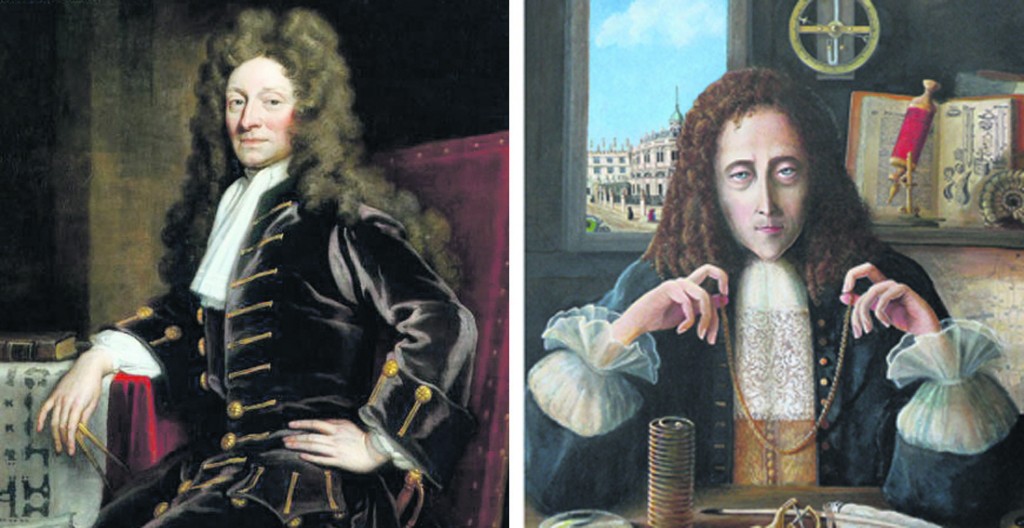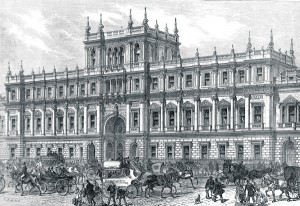WEDNESDAY, 18 JANUARY 2012
The current global economic turmoil, and its resulting austerity measures, are increasingly putting pressure on scientists to improve the social impact and application of their research. Whilst this can turn into a bureaucratic exercise for modern scientists, it was this very same necessity and desire to apply science that was at the heart of the formation of the Royal Society—the world’s longest continuously running scientific society.One late November evening in 1660, against a backdrop of a country beginning to recover from great political divides caused by the civil wars, twelve eminent men gathered in London. Putting aside the differences in their pasts, these gentlemen met at Gresham College to hear a lecture given by the young astronomer, Christopher Wren. Many of those present were already members of the so-called ‘Invisible College’—a group of notable men including Wren, Robert Hooke, Robert Boyle and John Wilkins, who met in the gardens of Wadham College, Oxford. They used their meetings to perform experiments and discuss natural philosophy, or as we now call it, science, and they were very keen to expand their group.
The gentlemen who met that November night were also ardent followers of the Baconian method of science. This method had recently emerged from Cambridge alumnus Francis Bacon’s Novum Organum, published in 1620. Bacon encouraged abandoning the Aristotelian method of science and suggested placing emphasis on cooperative research, using empirical methods to gain knowledge about the natural world. Driven by a key Baconian principle that ‘knowledge is power’ and a genuine desire to deliver applicable science, these gentlemen set out to formalise their ‘Invisible College’. In signing their names in a ledger, they became the first fellows of the ‘Colledge for the Promoting of Physico-Mathematicall Experimentall Learning’ (sic). Effectively, they accelerated the movement of science away from the somewhat amateurish hobby of the aristocracy, performed in country manor house laboratories, to a more centralised, open and collaborative affair.
The motto of the ‘Invisible College’, ‘Nullius in verba’, loosely translates to ‘Take nobody’s word for it’, and it reveals the Society’s desire to be at the frontline of science. Each week at their meetings at least one experiment would be performed, ranging from dissecting a dolphin to transfusing blood from a sheep to a human and looking at slides under the newly designed microscopes.
They were also particularly intrigued by foreign lands. In those early days, Tenerife was a particularly popular discussion point, as its central peak was thought to be the tallest known to man. As a result, the Society looked to study the fluidity of air by designing experiments to be conducted on the island. They would establish, for example, whether sand in an hour glass flowed faster at the peak of the mountain or whether altitude affected the ability of birds to fly. In the light of modern times, their experiments seem very basic. However, at the time relatively little was known about our world, and everything was open to investigation.
Unfortunately, their questions were left unanswered, as the expedition was never able to take place. Nonetheless, the society was never at a loss as to what to discuss. They were sent communications detailing novel discoveries from all over Europe. From Christopher Merrett they received observations outlining the practice of double fermentation, which is still used today in making champagne, whilst Antonie van Leeuwenhoek sent descriptions of microorganisms. During this time, founding member Henry Oldenburg established and financed the Society’s journal, The Philosophical Transactions of the Royal Society of London, to publish results and correspondence. It is still in press today and is the oldest scientific journal, first being published in March 1665.
The Society gained its royal status and name in 1662 with a Royal Charter granted by the newly restored King Charles II. The King, whose annual income was only £1.2 million, was very attracted by the Society’s promise of monetary remuneration from the application of science. In return, the charter would grant the Society many benefits, including the right to free press without censure. Under the King, many of the Society’s projects indeed proved of practical worth to the country. John Evelyn wrote about the correct management of forests to maintain steady supply of timber for the building of naval ships. Similarly, in a project for the navy, Hooke penned his famous law describing the properties of springs, whilst trying to make a watch that would measure longitude. Fellows of the Royal Society were also key players in the rebuilding of the capital after the Great Fire of London in 1666. Wren, for example, designed St. Paul’s Cathedral as it still stands today.
Much of the Society’s work was truly inspired, but it was often not as applicable as the King would have liked. The society was often subject to ridicule in satirical plays and novels, such as in Jonathan Swift’s famous story Gulliver’s Travels, which mocked the Society’s fascination with foreign lands. Throughout its history, the Society has made errors in judgment. In fact, Hooke objected to a letter from Isaac Newton about Newton’s observations of light passing through a prism. Further disservice was caused to Newton when the Society passed up on publishing his groundbreaking Principia Mathematica in favour of Francis Willughby’s De Historia Piscium, which turned out to be a flop and a great economic burden to the Society. Luckily another fellow, Edmund Halley, of Halley Comet fame, would fund the publication of Newton’s work, and Newton would eventually put aside his resentment and become president of the Society.
One truly remarkable and defining trait of the Society, which was evident from the beginning, was its extraordinary ability to overcome obstacles caused by huge differences in backgrounds. Hooke was the son of a priest and as such was an impoverished academic, whilst Boyle was the wealthy son of the Earl of Cork; Wilkins was a stout supporter of Cromwell, whilst Sir Robert Moray was a royal courtier.
Nationality, too, was no impediment in gaining fellowship—Oldenburg was a German national, and later Benjamin Franklin, an American, would also become a member. Additionally, traditional academic achievement was not a requirement for recognition by the Society; van Leeuwenhoek was a Dutch tradesman who spoke no Latin or English. Work was also accepted from the clergy, such as Reverend Thomas Bayes, who produced Bayes’ Theorem, which deals with probability and is used in supercomputers today.
Today the Society has about 1500 fellows, including 100 foreign fellows. Whilst most fellows now have doctorates, the Society still recognises ‘non-scientists’—in 2010 a group of primary school children published an article on bumblebees in one of the Society’s journals. It would thus seem that the aims set out by those twelve men over 350 years ago is still very much alive in our modern day society.
Nicola Stead is a PhD student at the Babraham Institute


